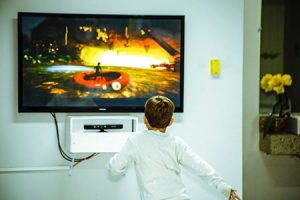Living With Best Disease

You may not realize that you inherited Best disease—vitelliform dystrophy—until adolescence. By this time, daunting questions like “Will I be able to drive?” or “What about college?” may disturb your sleep at night.
State-of-the-art custom low vision optical glasses and devices have enabled many people with Best disease and similar conditions to do things they didn’t think were possible.
At The Low Vision Institute, we have chosen to dedicate our professional lives to providing a future for people with vision loss. As a member of the International Academy of Low Vision Specialists (IALVS) our doctors have the knowledge and experience needed to find solutions to empower you to do the things that are important to you. Contact Dr. Marc Gannon to help you take the wheel and steer towards a hopeful future.
How Best Disease Impacts Day-to-Day Activities
Best disease is a type of juvenile macular degeneration. It affects the part of the eye responsible for central vision, called the macula. This impacts your daily routine, your ability to drive, read, study, see the screen of a phone or computer – in short, all activities that require good central vision. Fortunately, low vision optometrists, such as Dr. Marc Gannon, can help with many of these activities.
Best Disease and Driving
Central vision is essential for safe driving and reading road signs. Although affected, for many people, Best disease does not reduce vision to the point where they can’t drive. Many patients with this condition keep their driver’s license until late in life, especially with the use of low vision glasses.
In most states, low vision optometrists can help you maintain your license and get you driving again, using innovative low vision glasses custom made to your prescription. Bioptic telescope lenses are the most common, as well as E-scoop lenses, which may increase contrast and reduce blur.
Independence With Best Disease
Best Vitelliform Dystrophy does not lead to complete vision loss, so it’s rare to lose your independence. It is a slow-progressing disease, which stops at a certain point. Most people’s vision remains better than 20/100. There are devices to help perform all activities, including driving, reading, playing games, and live a completely independent life even with low vision.
What Is Best Disease?
Best disease, also called Vitelliform Dystrophy or Vitelliform disease, is an inherited form of juvenile macular degeneration. The macula is a tiny area on your retina in the back of your eye, responsible for central vision.
An eye care professional can usually diagnose the disease in childhood, even though it impacts vision only later in life, as it develops through its stages. You will not experience any pain, and Best does not cause damage anywhere else in the body.
The Stages of Best Vitelliform Disease
 The disease progresses in five stages. Sometimes changes in vision can occur in the early stages, but more often, vision loss is minor till stage four or five. Each patient can experience different symptoms. Also, the pace of progression differs from person to person. An eye care professional can identify the stage of the condition.
The disease progresses in five stages. Sometimes changes in vision can occur in the early stages, but more often, vision loss is minor till stage four or five. Each patient can experience different symptoms. Also, the pace of progression differs from person to person. An eye care professional can identify the stage of the condition.
- Stage one – no effect on vision, the macula looks healthy.
- Stage two – no, or very little effect on vision – a blister that resembles an egg yolk appears on the macula. The stage is also called the vitelliform stage.
- Stage three – still little, or no effect on vision – some of the yellow matter breaks through the retina, forming a cyst underneath the retina. This typically happens in the teenage years.
- Stage four – you will start noticing changes in your vision – the cyst (or lesion) breaks up, causing damage to some cells on the retina.
- Stage five – the final stage of the disease, where vision is more severely disturbed. The yellow substance withdraws, leaving behind scars and damaged cells on the retina. This phase is also called the atrophic stage.
A minority of patients develop an additional stage, called choroidal neovascularisation (CNV). The body attempts to fix the damage by creating new blood vessels. Unfortunately, this leads to further damage and deterioration of vision. There is some medical treatment to limit the damage to new blood vessel growth.
What Causes The Condition?
Best is genetically transferred from one parent by an autosomal dominant pattern of inheritance. What does that mean? The source of the condition is a faulty gene. If the faulty gene is passed down from one of your parents, it dominates over the healthy gene from the other parent.
There is also a possibility that the parent with Best disease does not pass down the mutated gene, in which case the child does not inherit the disease. There is a 50/50 chance to inherit the condition if one parent has the disease.
If one of your parents has the condition, have your eyes checked to see if you inherited it and consult a low vision optometrist.
Symptoms of Best Disease
An eye doctor may diagnose the disease, even though you don’t notice any significant symptoms. Typically this happens between the age of 3 – 15.
- You may see a blurry area or a smudge in the center of your visual field, making it hard to see detail.
- As the disease progresses, straight lines may become wavy or seem to have a bump in the middle.
- The central part of what you see becomes distorted, making it hard to read.
- In later stages, some people develop a blind spot in their central vision.
Will the Symptoms Get Worse?
 The disease progresses slowly through the stages. Most people will experience some symptoms when they are teenagers. Over the following years, they can gradually intensify. However, until the age of 40 – 50, most patients do not experience a severe deficiency in their vision.
The disease progresses slowly through the stages. Most people will experience some symptoms when they are teenagers. Over the following years, they can gradually intensify. However, until the age of 40 – 50, most patients do not experience a severe deficiency in their vision.
About 88% maintain 20/40 vision or better for many years, and most patient’s vision does not deteriorate below 20/100. Even though the condition is usually binocular – affects both eyes – most people retain reading and driving vision in at least one eye.
Low vision optometrists, such as Dr. Marc Gannon can help at any stage and suggest solutions to enable you to perform the tasks that are important to you.
Does Best Disease Lead to Blindness?
Even though the condition progresses, it does not lead to blindness. In the majority of cases, a low vision optometrist can help maximize the remaining vision.
Best disease does not affect peripheral vision, but only the macula area on your retina. The retina is located at the back of your eye, where the light broken by the lens forms an image. A tiny part of it is called the macula, and it contains millions of light-sensitive photoreceptors called cone cells.
The rest of the retina is made up of a different type of cell, called rod cells. The disease does not afflict these. Therefore peripheral vision remains intact.
Is There a Treatment or a Cure?
Unfortunately, so far, there is no effective medical or surgical treatment for Vitelliform macular degeneration.
Different universities around the world are researching the responsible gene called BEST1 in the hope of developing effective gene therapy. The studies yielded some positive results in animals, and scientists hope to achieve the same for humans.
This does not mean you have to surrender to being a victim of the disease. There are many ways to manage the condition and low vision optometrists, who devote their lives to helping people cope with this and similar conditions. They can offer devices to improve the quality of your life.
Why Go to a Low Vision Optometrist?
To start with, an IALVS low vision optometrist, such as Dr. Marc Gannon will listen to your concerns and which tasks you may be struggling with. At The Low Vision Institute we will then work together with you and find the devices that will maximize your vision for the tasks that matter to you.


